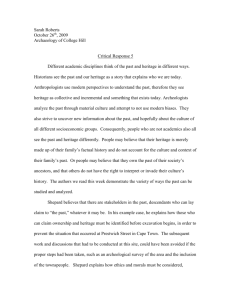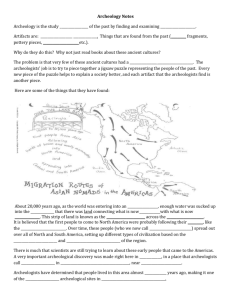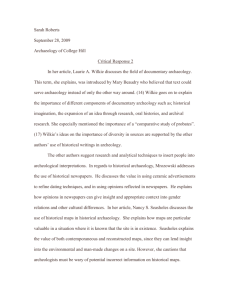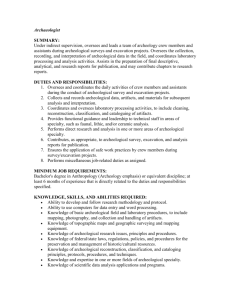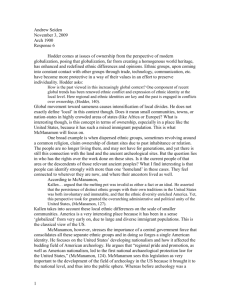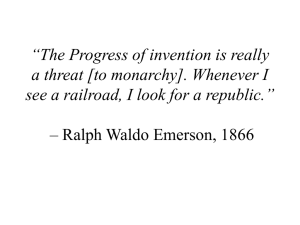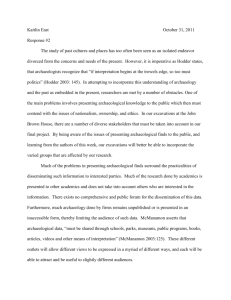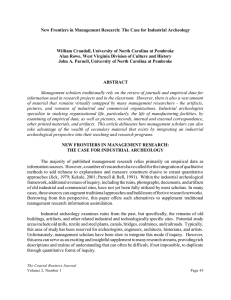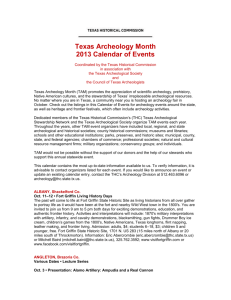Ian Brownstein ARCH1900 Critical Response Six
advertisement
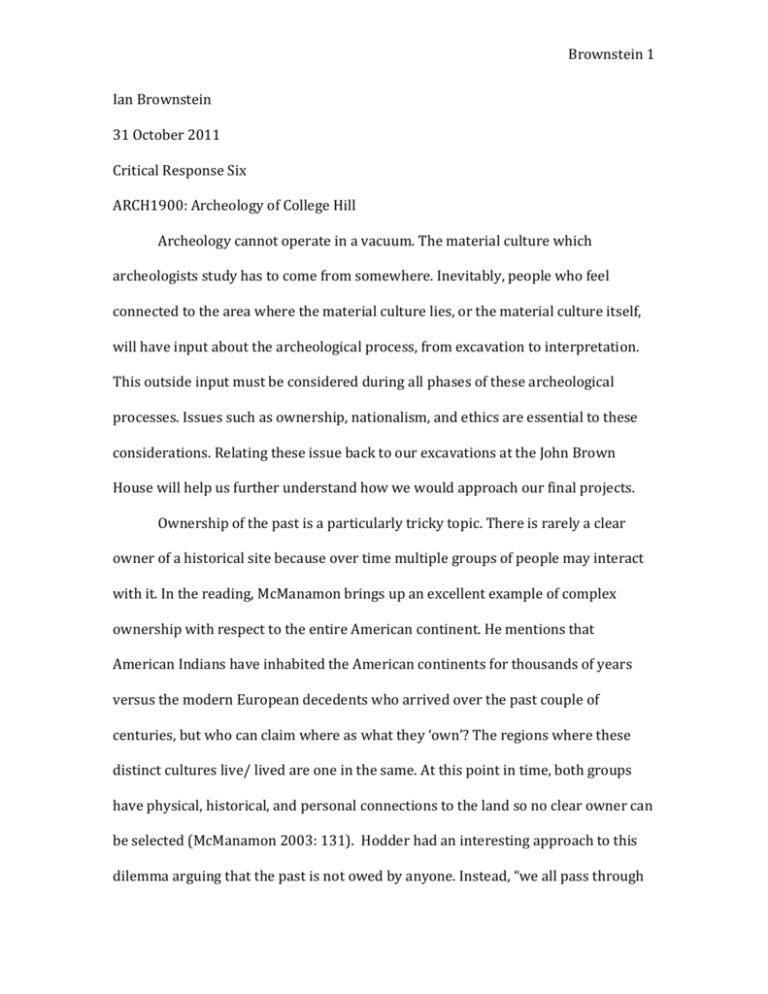
Brownstein 1 Ian Brownstein 31 October 2011 Critical Response Six ARCH1900: Archeology of College Hill Archeology cannot operate in a vacuum. The material culture which archeologists study has to come from somewhere. Inevitably, people who feel connected to the area where the material culture lies, or the material culture itself, will have input about the archeological process, from excavation to interpretation. This outside input must be considered during all phases of these archeological processes. Issues such as ownership, nationalism, and ethics are essential to these considerations. Relating these issue back to our excavations at the John Brown House will help us further understand how we would approach our final projects. Ownership of the past is a particularly tricky topic. There is rarely a clear owner of a historical site because over time multiple groups of people may interact with it. In the reading, McManamon brings up an excellent example of complex ownership with respect to the entire American continent. He mentions that American Indians have inhabited the American continents for thousands of years versus the modern European decedents who arrived over the past couple of centuries, but who can claim where as what they ‘own’? The regions where these distinct cultures live/ lived are one in the same. At this point in time, both groups have physical, historical, and personal connections to the land so no clear owner can be selected (McManamon 2003: 131). Hodder had an interesting approach to this dilemma arguing that the past is not owed by anyone. Instead, “we all pass through Brownstein 2 [a site] as travelers or tourists” (Hodder 2003: 141). Through this approach, everyone can claim a connection to the past through. Nationalism can be used in archeology as a strong political factor. In the 19th century, archeological sites were used as national symbols (McMamon 2003: 119). These sites tied into the American concept of manifest destiny as the nation pushed westward. The firs archeological preservation laws passed in the U.S where developed to protect these national symbols (McMamon 2003: 124). These sites were set aside because they were seen as part of the unique American identity and they where used to promote American nationalism. A more extreme example of the power of archeology in nationalism comes from Nazi Germany. The Nazi party took the idea of a coherent Germanic ‘fatherland’ which exteneded into eastern Europe and a superior Aryan race which existed in European antiquity from Kossinna, a archeologist who practiced just before the rise of Nazi Germany (Dawdy 2009: 132). Kossinna’s work was used heavily by the Nazi party and helped to shit the German nation toward Nazi ideals. This is a powerful example of the power of archeology and should serve as a warning that your writings as an archeologist can hold extreme value when interpreted. Archeology can also work for nationalism in addition to working toward nationalism. In Peru and Mexico, the establishment of nationals archeological organizations allowed these Latin American countries to take control of the archeology in there respective territories leading to local and regional financial benefits (Dawdy 2009: 136). As this shows, nations can use archeology to for internal benefit by controlling the archeology of there country. Brownstein 3 Ethical considerations when working on a site are paramount to the success of any project. In order for an excavation to be preformed in an ethical manner, it is important that the excavators share access to and control over the past (Beaudry 2009: 21). Beaudry gives the example of the Manhattan African burial ground, where the archeologists enraged the local African American population by not consulting them in the excavation of peoples whom they associated with. In order to keep up with possible ethical issues, archeologists have developed multiple organizations, such as the ASS and the AIA, which require their members to follow certain guidelines with regard to the ethics of digging. By following these guidelines, archeologists are forced to pay attention to the communities that surround their work. It is also important to consider public opinion of your proposed fieldwork when preparing to work on a site. While archeology can be well intentioned to provided educational value, entertainment, economic opportunity, etc. “[t]his is an agenda set not by community members but by archeology” (Dawdy 2009: 137). In order for archeology to provide benefit to the community around a site, archeologists have to “stop trying to do heritage” (Dawdy 2009: 132). Most communities’ living in the proximity of archeological sites are poor and the largest benefit to them would be economic stimulation brought in by the project (Dawdy 2009: 140). A great example is the influx of archeological work in the United States during the Great Depression due to the Works Progress Administrative, which was part of President Roosevelt’s larger national stimulus plan. Another mode of considering the opinion of the public around a site is to think about how different visitors of the site will interact. Hodder Brownstein 4 works with anthropologists and sociologists to understand the global and local communities the travel to the site and interact (Hodder 2003: 142). It is defiantly important to consider how people will interact on a site when it is possible that people of very different cultures will be interacting there. You do not want to offend any one group in a location you are trying to keep open and share to the world. The current excavations at the John Brown House demonstrate many of the ideas expressed in this weeks reading. The major stakeholders relevant to our excavation are the Joukowsky Institute, Brown University, the Rhode Island Historical Society (RIHS), and the John Brown House museum. The issue of ownership of the John Brown House is almost a non-issue since it has been passed down as a single plot of land until the present day when the RIHS owns in. Complications would arise here if a decedent of John Brown laid claim to the land based on some sort of lost documentation but this would be unlikely. The John Brown House is a symbol for the state of Rhode Island and American nationalism. Its close associations with the revolutionary war and the development of industry in New England make it a strong symbol of pride for the state and, to a smaller degree, the nation. It is preserved by the RIHS, which is and organization created under the same ideals as the Progressive Movement laws, which protect the southwestern sites, which McMamon wrote of. With respect to the ethics of the John Brown House excavation, it is important to take into consideration the history of slavery on the property and how the local community reacts to our ongoing research. Depending on the responses we get, it may be valid to alter the course of excavation for the Brownstein 5 future. It may also be useful to talk to decedents of John Brown to see how they feel about our work. Works Cited: Beaudry, Mary. 2009. "Ethical Issues in Historical Archaeology." In The International Handbook of Historical Archaeology, ed. by Teresita Majewski and David Gaimster. Springer, New York, 17-29 Dawdy, Shannon Lee. 2009 "Millennial Archaeology. Locating the Discipline in the Age of Insecurity." Archaeological Dialogues 16, no. 2 (2009): 131-142, 186-193 Hodder, Ian. 2003. “Sustainable Time Travel: Toward a Global Politics of the Past.” In S. Kane, ed., The Politics of Archaeology and Identity in a Global Contest, 139-147. McManamon, Francis P. 2003. “Archaeology, Nationalism, and Ancient America.” In S. Kane, ed., The Politics of Archaelogy and Identity in a Global Contest, 115-138.
